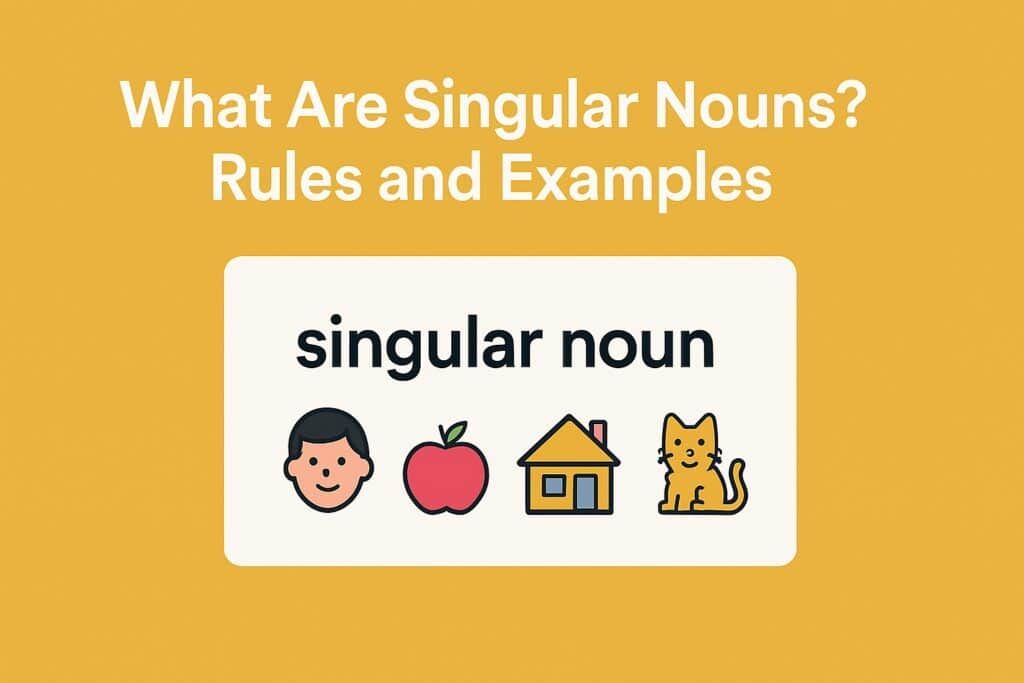Nouns are the words we use to name people, places, things, animals, and abstract ideas. They’re a core part of speech in English and can be categorized in dozens of ways
Whenever we talk about how many of something there is, i.e., quantity, we turn to singular and plural nouns.
And in this article, I’ll focus on what is a singular noun, how it is formed, how it is used in sentences, and how it differs from plural forms.
Let’s get right into it.
Key Takeaways
- A singular noun names one person, place, thing, or idea and uses the base form of the word with no added “s” or “es.”
- Some singular nouns naturally end in “s” (like business or news), but that doesn’t mean they’re plural, and no changes are needed to make them singular.
- Singular nouns require singular verbs, articles, and pronouns. Subject-verb agreement and proper use of “a” or “an” is crucial for grammatical accuracy in writing.
- Mistakes while using singular nouns in sentences often come from mismatched subject-verb pairs, article misuse, or confusing irregular forms.
Definition of a Singular Noun

At its core, “singular” just means “one.” When we say “singular noun,” we mean one person, one place, one thing, or one idea. That means cat, city, book, or thought are all singular nouns.
The structure of a singular noun is the simplest. The original, base version of a word that names the person, place, or thing usually denotes a singular noun.
If you say apple, you’re talking about a single apple. However, when an -s is added to it, as in apples, you’ve moved on to plural noun territory.


Never Worry About AI Detecting Your Texts Again. Undetectable AI Can Help You:
- Make your AI assisted writing appear human-like.
- Bypass all major AI detection tools with just one click.
- Use AI safely and confidently in school and work.
Don’t confuse a singular noun with a singular pronoun. A singular noun names the person, place, or thing, while a singular pronoun replaces that noun with words like he, she, it, or this.
For example, in the sentence “The chair is broken, and it needs to be fixed,” chair is the singular noun, and it is the singular pronoun.
If you ever find yourself staring at a word and wondering, “Is this singular or plural?,” you can always pop over to Ask AI.
It’s a study assistant where you type in the word or sentence, and it’ll explain whether the word is singular or plural and how it fits into the grammar of your sentence.
Examples of Singular Nouns
Since you’ve got a clear idea of what a singular noun is, let’s look at some real examples. Each of the words below refers to a single unit.
- Person: doctor, student, friend, child
- Place: city, school, restaurant, home, country
- Animal: dog, cat, elephant, chicken, duck, eagle,
- Thing: book, phone, chair, pen, spoon
- Idea: freedom, happiness, truth
Rules for Forming Singular Nouns
When it comes to forming singular nouns, there isn’t much of a rule at all. Singular nouns are usually just the base form of the word.
You don’t have to add anything or tweak the spelling in any way. The word stays as it is.
For example, book, car, apple, student, all of these are singular, and they’re already in their correct form.
You don’t add an “s” or “es” to make them singular. In fact, adding an -s or an -es turns these words into plurals.
That said, some singular nouns do naturally end in “s” or “es,” that doesn’t mean they’re plural. Take bus, glass, or dress for example, you don’t drop the “s” to make them singular. It’s part of the word.
The point is, you don’t add anything to make a noun singular. If the word already ends in “s” or “es,” you leave it as it is.
Any time you’re confused about whether you have used singular nouns correctly, get your writing scanned by a free Grammar Checker for mix-ups in noun usage.

Singular Nouns in Sentences
Seeing singular nouns in sentences is one of the best ways to understand how they work. A singular noun in a sentence comes with a singular verb to match.
That agreement between the subject (the noun) and the verb is necessary for grammatically accurate writing.
Here are some examples for you:
- The cat sleeps on the couch.
(Cat is a singular noun, and sleeps is the matching singular verb.) - A student asks a question.
(Student refers to one person, so the verb asks fits that singular subject.) - This book belongs to Sarah.
(Book is one item, and the verb belongs keeps the sentence consistent.) - The phone rings loudly.
(Phone is singular, and so is the verb rings.) - Freedom matters to everyone.
(Freedom is an abstract, singular noun, and matters is the correct singular verb.)
Singular Nouns vs Plural Nouns

Singular nouns and plural nouns are the foundation of how we talk about quantity in English.
The main difference between singular and plural nouns is number. Singular means one, and plural means more than one.
This difference, however, changes the structure of the sentence, the form of the verb, and even the articles and pronouns that go with the noun.
Here’s a clear side-by-side comparison between them:
Key Differences and Examples
Singular nouns require singular verbs, and plural nouns require plural verbs.
This is one of the most common places where students learning English tend to make mistakes.
- The dog barks loudly. (dog is singular, so we use barks)
- The dogs bark loudly. (dogs is plural, so we use bark)
Articles and determiners also behave differently with singular vs plural nouns.
You’ll see a or an used before singular nouns, like a book or an apple, but those don’t make sense with plural nouns.
Instead, you use words like some, many, or simply remove the article, e.g., some books, books, or the books.
Pronouns connected to the noun also differ. For instance, you’d say it for a singular noun, and they for a plural one.
- Singular: The chair is broken. It needs to be fixed
- Plural: The chairs are broken. They need to be fixed.
Based on these differences, it is natural to wonder, are plural nouns more difficult to understand than singular nouns in a sentence?
A study conducted reading experiments to compare reading times for sentences using both noun types and found no difference in processing based on whether the noun was singular or plural.
Irregular Plurals: when singular doesn’t just “+s”
Unfortunately, English isn’t always very simple. Although many nouns become plural by just adding “s” or “es,” some nouns are irregular, which means their plural forms don’t follow the usual pattern.
These you just have to memorize over time.
Here are some common irregular plurals:
- child → children
- man → men
- woman → women
- mouse → mice
- foot → feet
- tooth → teeth
- person → people
There are also words like sheep, deer, and species that stay exactly the same whether they’re singular or plural:
Look at this example:
- There is a deer in the forest.
- There are five deer in the forest.
Common Mistakes with Singular Nouns
Although learning about singular nouns seems very simple at first, there are some errors quite common among language learners that lead to grammatically incorrect sentences.
Understanding these common mistakes will help you avoid them and build stronger, more natural writing.
- Mixing up singular nouns with plural verbs
Many students end up with sentences like “The student write well” instead of “The student writes well.”
In English, singular subjects need singular verbs, and this requires adding an “s” to the verb.
It’s the opposite of what many learners expect, especially those whose first languages don’t change verb forms like English does.
The noun student is singular, so the verb must match it, i.e., writes, not write.
AI Humanizer really helps with fixing awkward sentences that form due to inconsistent noun and verb agreement.
- Misusing articles or determiners
A singular countable noun almost always needs a determiner like a, an, or the. Saying “I saw dog in the park” is incorrect because “dog” is singular and countable. You need to say “a dog” or “the dog.”
Leaving out the article before a singular noun makes the sentence sound incomplete.
- Confusing irregular singular forms
There are some confusing words in English that look plural at first sight, and naturally, learners often get tripped by them.
For example, the word news ends in “s” but it is singular. When used in a sentence, it’ll be: “The news is surprising,” not “The news are surprising.”
The same goes for mathematics, politics, and economics. They all look plural because of an “s” at the end, but take singular verbs.
Some people also forget that not every noun takes an “s” to become plural.
For instance, saying “childs” instead of “children” or “persons” instead of “people.” These irregular nouns have to be learned individually. There’s unfortunately no shortcut.
FAQs About Singular Nouns
Is “Information” a Singular Noun?
Yes, “information” is an uncountable singular noun. It does not have a plural form and is always treated as singular in sentences, even when you refer to multiple pieces of information.
Can a Singular Noun End in –s?
Yes, some singular nouns naturally end in “-s,” such as business, news, or chess. The “-s” doesn’t make them plural.
What’s the Singular of “Data”?
The singular form of “data” is “datum,” however, this rule is not strict, even in formal, academic writing. Modern English treats “data” as both the singular and plural forms.
Do All Singular Nouns Take “a” or “an”?
No. Only singular, countable nouns take “a” or “an”, for example, a cat, a pen, an ant, etc,. Uncountable nouns like water or furniture don’t use these articles.
What is a Singular Possessive Noun?
A singular possessive noun shows that one person, place, thing, or idea owns or has something.
You form it by simply adding an apostrophe and “s” (’s) to the end of a singular noun.
For example:
– The dog → The dog’s collar (the collar belongs to one dog)
– The teacher → The teacher’s desk (the desk belongs to one teacher)
Stay ahead of detection systems—verify and humanize your text with our tools below.
Final Thoughts
Getting the hang of singular nouns is one of those small wins that make you feel confident with English.
Once you really understand what makes a noun singular, how it behaves in a sentence, and how it differs from plural nouns, your writing and speaking start to feel more natural.
Of course, it’s not always easy. English is full of strange exceptions and silent rules that can throw anyone off—which is why Undetectable AI’s Grammar Checker is a total lifesaver.
If you’re working on an assignment and want to make sure you’re not misusing any singular nouns or messing up subject-verb agreement, this tool has your back.
Master your writing with Undetectable AI today—and turn grammar rules into second nature.
